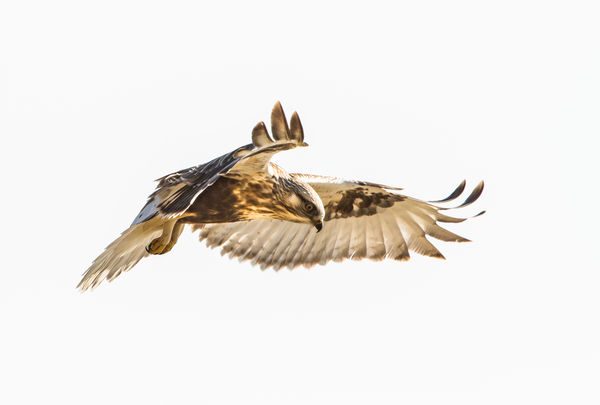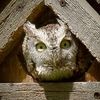A Primer for Capturing Images of Birds in Flight
This topic is locked to prevent further replies.
Jan 8, 2013 21:32:51 #
My Co-Moderator, BHowdy, has already posted his thoughts on the type of camera gear that is appropriate for BIF/BOW so I dont intend to go very far into that, except to say, since we are speaking about BIFs, you will need a decent DSLR with either a prime lens or zoom lens from 300-500 mm in length.
1.) Camera/lens setting suggestions: You should set your camera to tracking focus and, if possible, restrict your AF points to just a few at the center. I am reluctant to suggest using only one AF point because, for beginners, it can be frustrating trying to keep that point on the target. Set your camera to Aperture Priority at f/8. Set your camera to ISO 800. I know that is high, but it is necessary to obtain the shorter shutter duration you need to freeze BIF. In bright sun, this combination of f/stop and ISO will get you a shutter duration around 1/2000-sec, sufficient to eliminate both camera shake and most subject movement. Set your camera to high speed continuous shooting.
2.) Hand-held or tripod? I am going to suggest that you try hand-holding the camera. I generally find that it is easier to find and track the bird when my body, head and camera can move as one. Yes, there are times when I use my tripod, and I will make that the subject of a future post. It is possible to hand-hold a 500-mm lens, even the big f/4 Canon or Nikon lenses but, I wouldnt want to do that for any length of time. You do need to work up to it, and build up the upper body muscles. Most of us wont be shooting with a lens that heavy anyway.
3.) Know where the birds will be. Seems like an obvious statement but finding the birds is the most important first step. So many people say to me things like: I never saw a bird like that!or Where did you find that bird? Do the research for your area. Find out where the Wildlife Refuges are in your area. Find the City Parks, Arboretums, Rivers, Lakes, Ponds and Swamps, Oceans and Bays, Beaches and Coves near you that the birds frequent. Talk to people in your area, especially birders who are usually willing to help you find the birds. Contact your local Audubon Society. They can tell you the hot spots.
4.) Stance. Now for the brass tacks. Take a solid stance with the feet about shoulder width apart. Bring the camera up to your face and place it tight against your cheek and forehead. Cradle the lens from underneath with your left hand. Your right hand will obviously be holding the camera body. Bring both your elbows in to your body. The left arm will then support the lens and the right arm will help assure that the head and body work as one unit.
5.) Pan, focus, shoot, and follow through. Now comes a bird! Look over the top of the camera at the bird. This will help you point that long lens in the right direction. Move the camera up to your eye and find the bird in the viewfinder all the while tracking the bird and remembering to move your body and the camera as a unit. Initiate Auto Focus either with a half press of the shutter or with back button AF. When you have focus, begin taking pictures until the bird is just past you. Continue to pan with the bird for a second or so as this will help keep things smooth and steady. If it seems like a lot, dont worry. With a bit of practice this will become second nature, and really takes just a split second.
6.) Practice with larger common birds, such as Gulls, Herons Egrets, etc. Larger birds move more sedately and deliberately and are therefore easier to photograph in flight. Gulls are a favorite as they often congregate in numbers and are easy to bait in. they can be even be found far from water: The McDonalds parking lot, the local landfill etc. Just get out there and practice. Electrons are free!
In future posts, I will discuss specific camera settings that may help, how and when to use a tripod, using manual vs auto exposure control, special considerations for birds on the water, and any other subject that you suggest.
So post your pictures and ask your questions! Welcome to BIF/BOW!
1.) Camera/lens setting suggestions: You should set your camera to tracking focus and, if possible, restrict your AF points to just a few at the center. I am reluctant to suggest using only one AF point because, for beginners, it can be frustrating trying to keep that point on the target. Set your camera to Aperture Priority at f/8. Set your camera to ISO 800. I know that is high, but it is necessary to obtain the shorter shutter duration you need to freeze BIF. In bright sun, this combination of f/stop and ISO will get you a shutter duration around 1/2000-sec, sufficient to eliminate both camera shake and most subject movement. Set your camera to high speed continuous shooting.
2.) Hand-held or tripod? I am going to suggest that you try hand-holding the camera. I generally find that it is easier to find and track the bird when my body, head and camera can move as one. Yes, there are times when I use my tripod, and I will make that the subject of a future post. It is possible to hand-hold a 500-mm lens, even the big f/4 Canon or Nikon lenses but, I wouldnt want to do that for any length of time. You do need to work up to it, and build up the upper body muscles. Most of us wont be shooting with a lens that heavy anyway.
3.) Know where the birds will be. Seems like an obvious statement but finding the birds is the most important first step. So many people say to me things like: I never saw a bird like that!or Where did you find that bird? Do the research for your area. Find out where the Wildlife Refuges are in your area. Find the City Parks, Arboretums, Rivers, Lakes, Ponds and Swamps, Oceans and Bays, Beaches and Coves near you that the birds frequent. Talk to people in your area, especially birders who are usually willing to help you find the birds. Contact your local Audubon Society. They can tell you the hot spots.
4.) Stance. Now for the brass tacks. Take a solid stance with the feet about shoulder width apart. Bring the camera up to your face and place it tight against your cheek and forehead. Cradle the lens from underneath with your left hand. Your right hand will obviously be holding the camera body. Bring both your elbows in to your body. The left arm will then support the lens and the right arm will help assure that the head and body work as one unit.
5.) Pan, focus, shoot, and follow through. Now comes a bird! Look over the top of the camera at the bird. This will help you point that long lens in the right direction. Move the camera up to your eye and find the bird in the viewfinder all the while tracking the bird and remembering to move your body and the camera as a unit. Initiate Auto Focus either with a half press of the shutter or with back button AF. When you have focus, begin taking pictures until the bird is just past you. Continue to pan with the bird for a second or so as this will help keep things smooth and steady. If it seems like a lot, dont worry. With a bit of practice this will become second nature, and really takes just a split second.
6.) Practice with larger common birds, such as Gulls, Herons Egrets, etc. Larger birds move more sedately and deliberately and are therefore easier to photograph in flight. Gulls are a favorite as they often congregate in numbers and are easy to bait in. they can be even be found far from water: The McDonalds parking lot, the local landfill etc. Just get out there and practice. Electrons are free!
In future posts, I will discuss specific camera settings that may help, how and when to use a tripod, using manual vs auto exposure control, special considerations for birds on the water, and any other subject that you suggest.
So post your pictures and ask your questions! Welcome to BIF/BOW!
A tough, backlit, full frame shot of a Rough-legged Hawk hovering.

Feb 27, 2013 20:27:21 #
If you want to reply, then register here. Registration is free and your account is created instantly, so you can post right away.

